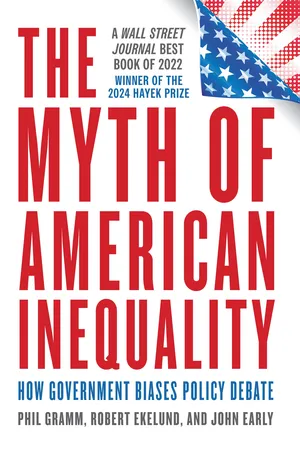
eBook - ePub
The Myth of American Inequality
How Government Biases Policy Debate
- English
- ePUB (mobile friendly)
- Available on iOS & Android
eBook - ePub
The Myth of American Inequality
How Government Biases Policy Debate
About this book
A Wall Street Journal Best Book of 2022: Politics • Winner of the 2024 Hayek Book Prize, Manhattan Institute
Everything you know about income inequality, poverty, and other measures of economic well-being in America is wrong. In this provocative book, a former United States senator, eminent economist, and a former senior leader at the Bureau of Labor Statistics challenge the prevailing consensus that income inequality is a growing threat to American society. By taking readers on a deep dive into the way government measures economic well-being, they demonstrate that our official statistics dramatically overstate inequality. Getting the facts straight reveals that the key measures of well-being are greater than the official statistics of the country would lead us to believe. Income inequality is lower today than at any time in post- World War II America. The facts reveal a very different and better America than the one that is currently described by policy advocates across much of the political spectrum. The Myth of American Inequality provides clear and convincing evidence that the American Dream is alive and well.
Everything you know about income inequality, poverty, and other measures of economic well-being in America is wrong. In this provocative book, a former United States senator, eminent economist, and a former senior leader at the Bureau of Labor Statistics challenge the prevailing consensus that income inequality is a growing threat to American society. By taking readers on a deep dive into the way government measures economic well-being, they demonstrate that our official statistics dramatically overstate inequality. Getting the facts straight reveals that the key measures of well-being are greater than the official statistics of the country would lead us to believe. Income inequality is lower today than at any time in post- World War II America. The facts reveal a very different and better America than the one that is currently described by policy advocates across much of the political spectrum. The Myth of American Inequality provides clear and convincing evidence that the American Dream is alive and well.
Frequently asked questions
Yes, you can cancel anytime from the Subscription tab in your account settings on the Perlego website. Your subscription will stay active until the end of your current billing period. Learn how to cancel your subscription.
At the moment all of our mobile-responsive ePub books are available to download via the app. Most of our PDFs are also available to download and we're working on making the final remaining ones downloadable now. Learn more here.
Perlego offers two plans: Essential and Complete
- Essential is ideal for learners and professionals who enjoy exploring a wide range of subjects. Access the Essential Library with 800,000+ trusted titles and best-sellers across business, personal growth, and the humanities. Includes unlimited reading time and Standard Read Aloud voice.
- Complete: Perfect for advanced learners and researchers needing full, unrestricted access. Unlock 1.4M+ books across hundreds of subjects, including academic and specialized titles. The Complete Plan also includes advanced features like Premium Read Aloud and Research Assistant.
We are an online textbook subscription service, where you can get access to an entire online library for less than the price of a single book per month. With over 1 million books across 1000+ topics, we’ve got you covered! Learn more here.
Look out for the read-aloud symbol on your next book to see if you can listen to it. The read-aloud tool reads text aloud for you, highlighting the text as it is being read. You can pause it, speed it up and slow it down. Learn more here.
Yes! You can use the Perlego app on both iOS or Android devices to read anytime, anywhere — even offline. Perfect for commutes or when you’re on the go.
Please note we cannot support devices running on iOS 13 and Android 7 or earlier. Learn more about using the app.
Please note we cannot support devices running on iOS 13 and Android 7 or earlier. Learn more about using the app.
Yes, you can access The Myth of American Inequality by Phil Gramm,Robert Ekelund,John Early in PDF and/or ePUB format, as well as other popular books in Economics & Economic Conditions. We have over one million books available in our catalogue for you to explore.
Information
Table of contents
- Preface
- 1 Introduction: Official Statistical Measures Understate America’s Well-Being
- 2 Inequality in Producing and Consuming in America
- 3 Poverty in America
- 4 Trends in Income Inequality
- 5 Causes of the Growth in Earned-Income Inequality
- 6 Measures of Well-Being
- 7 What about the “Super Rich”?
- 8 The American Dream Is Alive and Well
- 9 Fifty Years of Economic Progress
- 10 Policy Implications and Conclusions
- Appendices
- Notes
- About the Authors